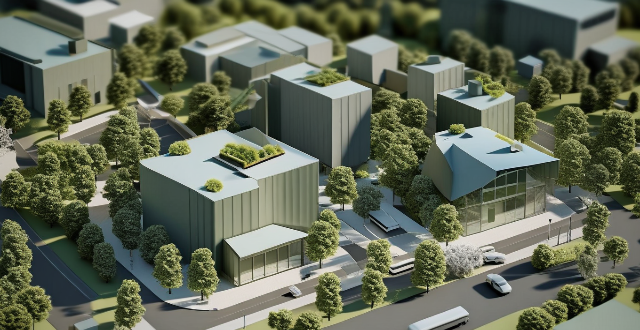Energy-efficient buildings are crucial for reducing carbon footprint by minimizing energy use and optimizing resources. They incorporate features like proper insulation, air tightness, advanced HVAC systems, renewable energy sources, and smart technology to reduce energy consumption, lower greenhouse gas emissions, and mitigate climate change impact. These structures offer benefits such as lower utility bills, increased comfort, reduced maintenance costs, and higher resale value. Energy-efficient buildings play a significant role in combating climate change and promoting a sustainable future.

Energy-Efficient Buildings: Reducing Carbon Footprint
Energy-efficient buildings play a crucial role in reducing carbon footprint by minimizing energy consumption and optimizing resource use. These structures are designed to reduce the amount of energy needed for heating, cooling, and lighting, which in turn lowers greenhouse gas emissions and mitigates the impact of climate change.
Key Features of Energy-Efficient Buildings
Insulation and Air Tightness
- Proper Insulation: Insulation materials help to maintain a consistent indoor temperature, reducing the need for heating and cooling systems.
- Air Tightness: Sealing gaps and cracks prevents air leakage, ensuring that conditioned air stays inside and unconditioned air remains outside.
Advanced Heating, Ventilation, and Air Conditioning (HVAC) Systems
- Efficient HVAC Systems: High-efficiency furnaces, boilers, and heat pumps significantly reduce energy consumption.
- Zone Control: Zoning systems allow individual control over different areas of a building, ensuring that only occupied spaces are heated or cooled.
Renewable Energy Sources
- Solar Power: Solar panels convert sunlight into electricity, reducing reliance on fossil fuels.
- Wind Energy: Small wind turbines can be used to generate power for individual buildings or communities.
Smart Technology and Automation
- Programmable Thermostats: Automatically adjusting temperatures based on occupancy and preferences reduces unnecessary energy use.
- Building Management Systems: Integrated systems monitor and control various aspects of a building's operation, optimizing energy efficiency.
Benefits of Energy-Efficient Buildings
Reduced Energy Consumption
- Lower Bills: Efficient buildings lead to lower utility bills for owners and occupants.
- Increased Comfort: Well-designed buildings provide a more comfortable living or working environment.
Environmental Impact
- Lowered Greenhouse Gas Emissions: Less energy consumption means fewer emissions from power plants.
- Sustainable Resource Use: Efficient buildings often incorporate recycled materials and promote sustainable practices.
Long-Term Cost Savings
- Maintenance Costs: Properly constructed buildings require less maintenance over time.
- Resale Value: Energy-efficient features increase a property's appeal and value.
Conclusion
Energy-efficient buildings are essential for reducing carbon footprint as they minimize energy waste and maximize resource efficiency. By incorporating insulation, advanced HVAC systems, renewable energy sources, and smart technology, these buildings not only cut down on greenhouse gas emissions but also provide cost savings and increased comfort for occupants. As we strive towards a more sustainable future, energy-efficient buildings stand at the forefront of this effort, offering a practical solution to combat climate change.